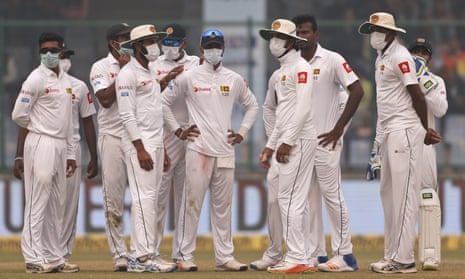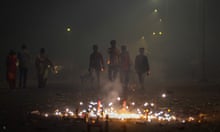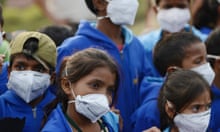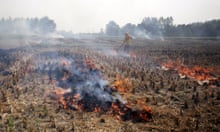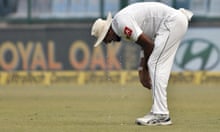A cricket Test match between India and Sri Lanka was repeatedly interrupted on Sunday with claims players were “continuously vomiting” due to hazardous pollution levels in the Indian capital.
Commentators said it was the first recorded instance of an international match being halted due to the toxic smog that afflicts much of north India year-round but worsens to hazardous levels during winter months.
Airborne pollution levels 15 times the World Health Organisation limits confronted players on the second day of the third Test at the Feroz Shah Kotla stadium in Delhi on Sunday.
As the haze worsened, many Sri Lankan players returned from lunch wearing face masks before complaining to umpires, who halted play for 20 minutes to consult with team doctors and match officials.
The match resumed but was interrupted twice more as bowlers Lahiru Gamage and Suranga Lakmal left the field mid-over with breathing difficulties.
“We had players coming off the field and vomiting,” the Sri Lanka coach Nic Pothas told reporters after the match.
“There were oxygen cylinders in the change room. It’s not normal for players to suffer in that way while playing the game.”
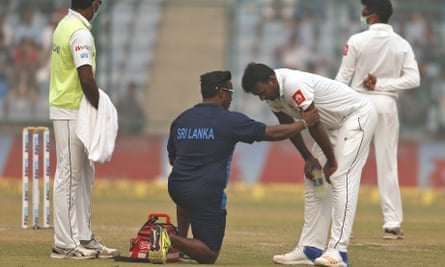
Pothas said Lakmal was “continuously vomiting” in the changing room. “I think it’s the first time that everybody has come across that situation,” he said.
“There aren’t too many rules regarding pollution. What we are going to do tomorrow is in the hands of the match referee. They will have meetings tonight to put in some sort of a precedent if it happens like this tomorrow.”
The Indian bowler Kuldeep Yadav was also seen sporting a face mask as he brought drinks to teammates on the field.
Umpires were awaiting Lakmal’s return to the field when the Indian skipper, Virat Kohli, elected to declare with his side cruising on 536 runs with three wickets in hand.
The interruptions drew boos from the crowd for Sri Lanka’s opening batsmen as they made their way to the crease, where they played without masks.
The acting president of India’s cricket board was also unimpressed and said he would write to his Sri Lankan counterpart about the incident.
“If 20,000 people in the stands did not have problems and the Indian team did not face any issue, I wonder why the Sri Lankan team made a big fuss?” CK Khanna said.
It is the latest professional-grade match in Delhi to be affected by air pollution after two matches in the domestic Ranji Trophy tournament were abandoned in the city when it was engulfed in smog in November 2016.
Some Indian fans accused the Sri Lankan side of being melodramatic but the cricket writer Ayaz Memon said the episode sent an “unedifying message” about pollution in the city.

Schools were shut and doctors declared a public health emergency in Delhi last month as pollution levels spiked to levels 40 times the WHO safe limits, likened to smoking at least 50 cigarettes in a day.
United Airlines briefly halted flights into the capital and foreign diplomats voiced fears the city could become a “non-family” posting due to the polluted environment.
Doctors warn against physical activity in the smog but around 30,000 runners still participated in an annual half-marathon in the city in November.
Delhi officials have been accused of not preparing for what has become an annual crisis each winter, while the Indian government has played down the urgency and health risks associated with the problem.
The extremely poor air in the city is the result of a combination of road dust, open fires, vehicle exhaust fumes, industrial emissions and the burning of crop residues in neighbouring states. Indian weather agencies also blame dust storms that originate in the Gulf.
Agence France-Presse contributed to this report
